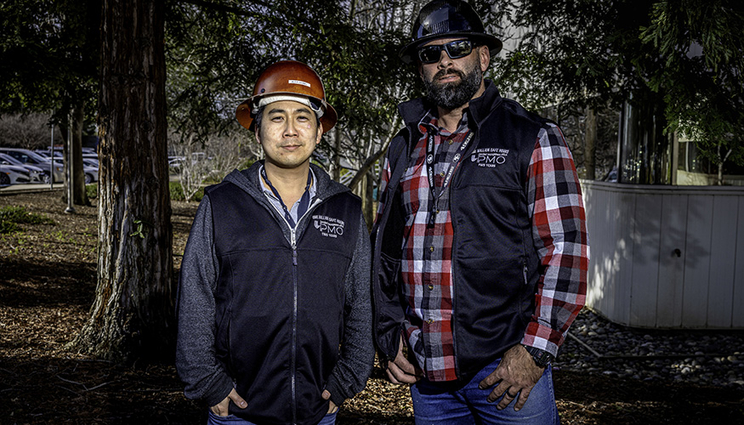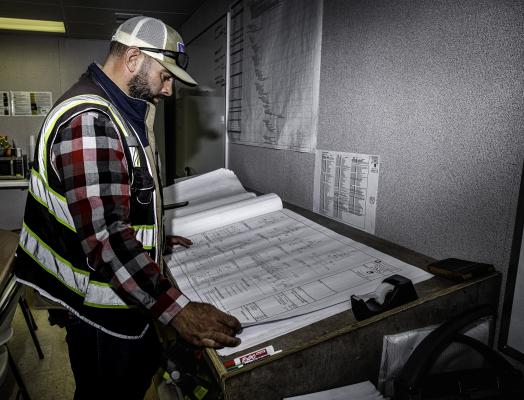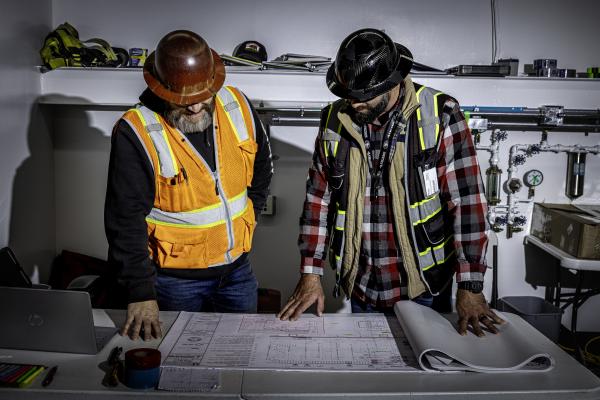A day in the life: LLNL’s construction managers
 (Download Image)
(Download Image)
Managers Alex Leung and Nick Gomes are part of a team of 23 busy construction managers in the Project Management Office who each handle up to 13 projects at a time. Photos by Glenn Silva/TID
One of 68 active construction sites at LLNL, Bldg. 310 is looking pretty sharp.
“This is where the pool was, and the locker rooms were over there,” said LLNL construction manager Nick Gomes, with a sweeping gesture across a new parking lot punctuated with just-planted landscaping over to a diminutive older building to the left that now houses a yoga studio. “It was huge.”
The Navy installed the pool, which was 50 meters long and about 25 meters wide, for pilots to practice ditching operations when they occupied Site 200 in the 1940s. It was closed due to damage in 2004, and new construction at the pool’s location required excavation of giant concrete footings that probably belonged to the structure that once covered it.
Archeologist is just one of the informal roles that construction managers (CMs) like Gomes occupy at LLNL. A dynamic mosaic made up of different layers of history, the Lab is in a constant state of transformation. Updating and adding infrastructure building by building, Gomes is one of a team of 23 busy construction managers who each handle up to 13 projects at a time, with three to four of those in construction and the remainder in the planning, design or procurement phases. Constantly on the move, the CMs’ attention to detail is what keeps the Project Management Office's (PMO) projects on track – all 238 of them.
Nick Gomes
Construction Manager Nick Gomes reviews plans at a work site.To start the day, LLNL CM Gomes attends as many Safe Plan of Action (SPA) meetings as he can (usually one or two), then comes back to the office to update his construction management records..
The rest of the day is spent fielding phone calls and doing job walks, during which they interface with contractors. When they’re not participating in design meetings and weekly status meetings, they are out in the field checking on progress and quality to make sure jobs are on track.
Gomes lives in Livermore about five minutes from the Lab and he has five children, all under 12 years old.
Not unlike raising five children, he points out that as soon as he plans the workday, it gets derailed by the unexpected. “It can happen fast – the phone is relentless,” he said.
Gomes started his career as a union carpenter. After about 10 years, he got his general contracting license and started his own company, spending the following decade as a contractor. During a job, he met Reno Dell’Acqua and several others from the Lab, who told him about an opening for a CM.
Gomes appreciates being able to come to the same job site every day and having retirement benefits he can count on.
“I do miss having my own company, but I love working here,” he said.
Alex Leung
Also a member of the CM team, Alex Leung comes from a commercial general contracting background and is experienced in the design-build model, where one entity handles both architecture and construction.
He’s managed ground-up projects like a new Whole Foods Market in Roseville and the Student Wellness Center at San Jose State, worked on tenant improvement projects like Verizon Innovation Center in San Francisco and renovated infrastructure for large companies like Union Bank HQ.
Leung later switched to the owner representation side of construction, and after working as a senior project manager at San Jose State, he came to the Lab about five years ago as a construction manager.
He now lives in Fremont and said it’s by far the best commute he’s ever had because the reverse commute gives him time to make it to his SPA meetings. During these meetings, the team goes through the task at hand with general contractors and subcontractors. They write a plan of action, look at hazards or controls needed, such as when a crane is used and try to anticipate any safety issues or additional materials needed.
Working for nine hours on an alternate work schedule (AWS) schedule, Leung, who has two children, ages 10 months and three years, notes that CMs often remain on email and text messaging into the evening.
“Unfortunately, the brain doesn’t shut off after we leave,” he said.
Both Leung and Gomes take their computers home with them. “If you don’t do that, you come in the next day and you’re already behind,” Gomes said. “Here we can take care of the work that needs to be done onsite, whereas the office work can go home with us.”
Collaboration is essential to success
Construction Manager Nick Gomes reviews plans with a contractor.“When we have a contractor that is so familiar with our processes, it makes things a lot easier,” Gomes said. “From our side, for the Lab it’s a win-win.”
As CMs assist and guide contractors, collaboration with multiple groups at the Lab is essential to success. From beginning to end, they work closely with Security, ES&H, Facilities and several other groups to ensure that their work meets Lab requirements and standards.
Before a project starts construction, CMs review plans with the contractor, asking how they interpret the drawings and if they foresee any challenges. The CM may ask for product data sheets on materials the contractor plans to use and shop drawings to ensure quality.
“Unfortunately, no design is perfect, and things come up all the time,” Leung said.
Projects begin with a Subcontractor Area Hazard Control List (SAHCL) and walk, allowing ES&H, Facilities and CMs to let contractors know about any existing hazards on the site that may affect their work before they provide a bid.
One key partnership is with the PMO Integrated Safety Team (PMO-IST). CMs work side by side with the PMO-IST to ensure all workers, facilities and the environment are protected. Both groups employ a safety first “coaching culture” intended to build trust and partnership with our subcontractors. This successful initiative led to PMO’s recent celebration of 1 million safe hours of work executed without a lost time injury over two consecutive years.
CMs work closely with Facilities Points of Contact (FPOCs), and together they look at power, water and telecommunications to see if nearby employees may be affected by construction activities. In addition to the disturbance of cutting off utilities, loud noise can bother occupants and vibration from construction work can affect sensitive equipment. When necessary, the construction team works to minimize the impacts by shifting work hours or collaborating on alternatives.
“We don’t touch anything or do anything until we get approval from the facilities manager, because we don’t want to affect the occupants next door,” Gomes said.
Physical and cyber security often overlap with construction, and CMs work with Locks and Keys to install physical access control systems. They also coordinate with the LLNL Fire Alarm Group to install an alarm panel in each building, and with LIVIT to make sure all cybersecurity standards are met.
Once all utility infrastructure in a building is ready to go, the High Voltage Group makes the final connection to power, and the Water Shop takes care of water tie-ins.
At various stages of the construction process, CMs work with the building department to make sure each project is built according to code, and in some cases, the Lab hires a third party to inspect specific aspects of a project. For example, if they have done soil grading and compacting before putting in a building, they may need to hire a firm to do compaction testing to make sure the structure doesn’t sink, or they may need to have concrete tested in a laboratory to make sure that a building is seismically appropriate.
CMs are also responsible for following up when things don’t go according to plan. If there is an injury or other off-normal event, the team pauses work and calls the safety team, facility management, supervisors, and assurance managers to evaluate what happened. This helps them to improve their process and prevent the same thing from happening in the future.
Responding to challenges
As schedule gatekeepers, CMs conduct schedule review meetings monthly and weekly and communicate the status to stakeholders so they know when future occupants will be able to use the building.
They also respond to last-minute changes in the weather and other variables that may cause delays. Following two weeks of major storms in January, roofs were often covered with ice in the early mornings, and many of the job sites needed time to dry out before contractors could make more progress.
The rain slowed construction, but teams took measures to make sure water didn’t impact things more than necessary. In one case, the team pumped excess surface water into a bioswale so that the soil didn’t continue to soak up the moisture. To keep progressing, teams worked indoors where possible.
The unusual storms underscored the fact that getting the roof on a building is a huge milestone, especially in the winter. Work on Bldg. 226, for example, was stopped during the wet weather, but a few weeks later, once the roof was on, the team was able to work on inside framing, sheetrock, plumbing and electrical.
While some rain days are written into their initial contracts, this year’s storms had more of an impact than originally expected. When things change mid-project, CMs create and review change orders and request modifications to the contract. They are flexible with contractors, keeping in mind that it’s the ongoing relationship with them that matters.
“We want these contractors to come back again and again,” Gomes said. “We do have that trust built. It’s ultimately a give and take.”
– Kimberly Moore
Contact
 Lauren Casonhua
Lauren Casonhua
[email protected]
(925) 423-3141
Related Links
LLNLTags
CareersFeatured Articles









